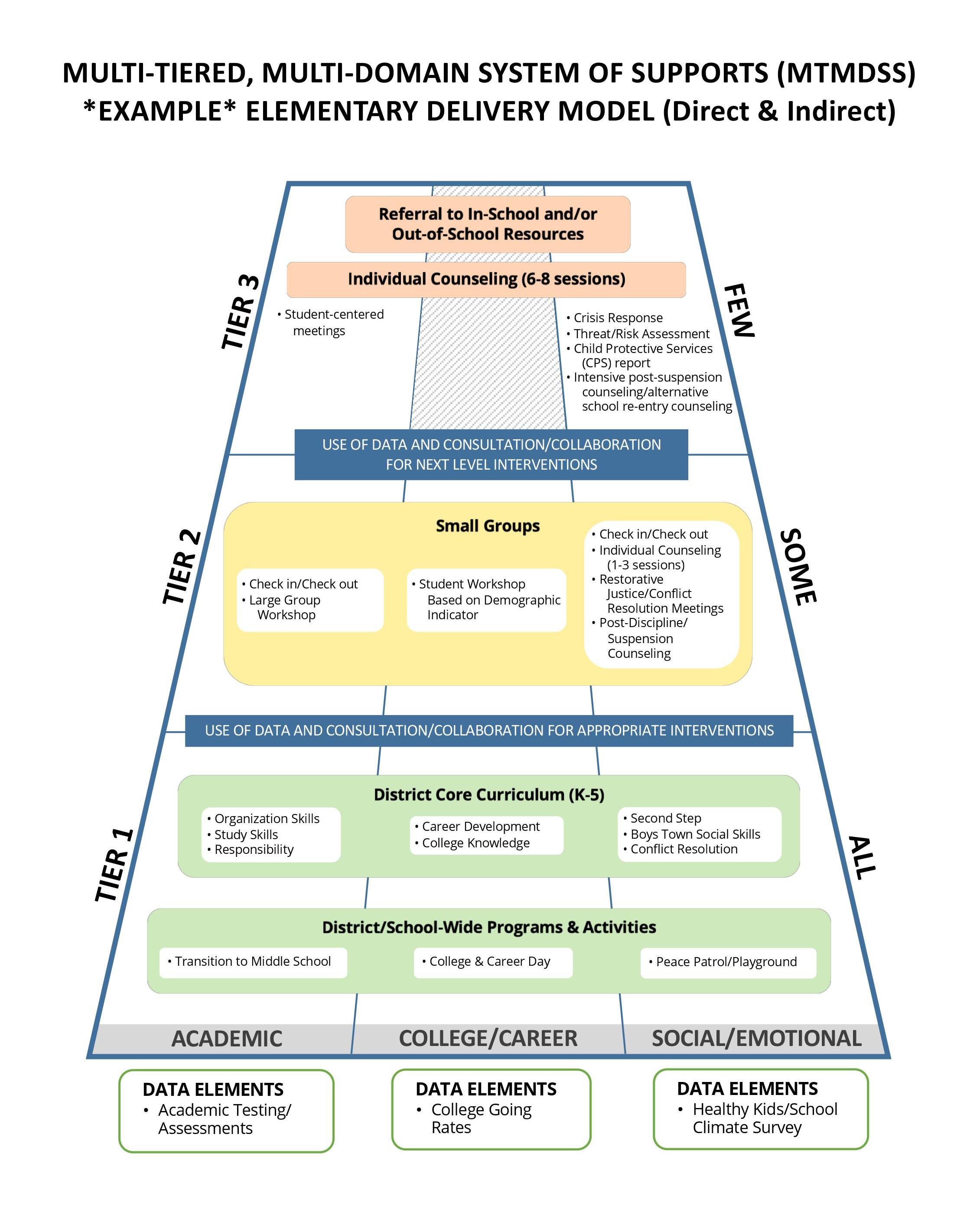Multi-Tiered, Multi-Domain System of Supports by Trish Hatch, PhD
/This article was updated in December 2023. View the original 2017 article on our Blog Archive.
The Multi-Tiered System of Supports (MTSS) is a comprehensive framework that addresses the academic and behavioral needs of all students within the educational system (Hawken, Vincent & Schumann, 2008; Framework for Safe & Successful Schools). Research shows that schools benefit from having available multiple evidence-based interventions of varying intensity to meet the range of behavioral, social-emotional, and academic needs of all students (https://www.ncbi.nlm.nih.gov/pmc/articles/PMC3004682/). Similar to its predecessor, Response to Intervention (RtI), MTSS is a tiered systems approach of increasingly intensive interventions to facilitate effective implementation of activities and services that focus on instruction and differentiated interventions to support the academic and behavioral success of all students.
MTSS is an integrated, comprehensive framework that aligns academic, behavioral, and social-emotional learning for the benefit of all students. One essential component of MTSS is the continuum of supports with intentional integration of services and supports to identify and meet the needs of all students (https://www.cde.ca.gov/ci/cr/ri/).
Tier 1 is foundational and represents the universal support ALL students receive through their general education program. Tier 1 programs and activities are implemented with the entire student population such as school-wide expectations and incentives and core instruction. Teachers, school counselors, and other educators utilize universal design for learning (UDL) and proactively differentiate (modify/adapt) their instructional practices to support students’ individual needs, providing a more challenging or more supportive learning environment as necessary.
Tier 2 is supplemental supports and interventions for students identified through the use of data identifiers/indicators. After investigating the root cause, teams carefully and intentionally select evidence-based interventions that are likely to produce desired outcomes and are aligned with student needs.
Tier 3 is characterized by increasingly intensified, tailored, and individualized supports for students with the highest level of need.
While MTSS is often focused on two areas (academics and behavior), the focus of the work of the school counselor is in three domains: 1) academic, 2) college/career, and 3) social/emotional. To reflect this alignment with the work of the school counselor, the Multi-Tiered, Multi-Domain System of Supports (MTMDSS) was created in 2016 and published in the Hatching Results blog in 2017 and is depicted in the image below. Similar to the MTSS continuum of supports, the Multi-Tiered, Multi-Domain System of Supports (MTMDSS) is a program planning and decision-making framework that utilizes an evidence-based practice approach to school counseling Tier 1 classroom curriculum and instruction, Tier 2 targeted interventions, and Tier 3 intensified supports aligned with assessments to provide the necessary supports for ALL students in the three domains of school counseling: academic, college and career, and social/emotional.
Comprehensive school counseling programs are an integral part of the total educational program for student success. The entire school community is invested in student academic achievement, college and career readiness and social emotional wellbeing. School-wide proactive, preventative and data driven intervention services and activities belong to the entire school. Therefore, it is recommended that schools add the third domain (college and career readiness) to their MTSS continuum of supports to fully embrace and reflect the importance of a tiered approach to college and career readiness supports.
Figure 1
MULTI-TIERED, MULTI-DOMAIN SYSTEM OF SUPPORTS (MTMDSS)
The MTMDSS is a framework (See Figure 1) specifically for school counseling programs to organize a continuum of instruction and interventions to meet students’ needs with the goals of: 1) Ensuring all students receive developmentally appropriate instruction; 2) Maximizing student achievement; and 3) Increasing the social, emotional, and behavioral competencies of students. The MTMDSS framework organizes school intervention services into three levels, or Tiers.
Tier 1: Universal Supports – For All Students
Tier 1 consists of the delivery of services that all students receive (curriculum, individual student planning, school-wide events). Standards- and competency-based school counseling curriculum (formerly called guidance and/or core curriculum) is developmental in nature, preventative and proactive in design, and comprehensive in scope. Individual Student Planning includes 4 to 6-year and college/career planning and career readiness (generally for students in grades 6-12). School-wide activities align with classroom lesson content and support the program for all students, such as national awareness weeks and celebrations, conflict resolution programs, and family education programs.
Tier 2: Supplemental Support (Targeted Interventions) – For Some Students
Supplemental supports are targeted data-driven interventions are designed for students who are identified by prescheduled and predetermined data screening elements. For example, these data screening elements include: attendance rates, behavior, work skills and study habits (report card marks), course failure, credit deficiency and/or equity and access issues. Tier 2 includes short term progress monitoring and collaboration among teachers, staff, families, and the school counselor/student services team until improvement and/or referral to appropriate services can be found and implemented. Tier 2 activities are designed for students who: 1) exhibit barriers to learning; 2) are struggling to achieve academic success; and/or 3) who are identified as deserving of additional instruction and/or other support in addition to Tier 1 curriculum activities (For example: foster youth, dual language learners, students in transitional living situations, historically oppressed populations, etc.).
Tier 3: Intensified Support – For A Few Students
Intensified support is provided by school counselors as members of the student services team, largely through indirect student support services such as consultation, collaboration, and facilitation of referrals (Goodman-Scott, et al., 2020). Intensified support is often provided by school counselors through individualized student counseling and interventions (e.g. 1:1 crisis counseling). These intensified supports are designed for students with an immediate need and are often in response to emergency and/or crisis response events. Intensified support includes short-term solution-focused counseling to address life-changing events (such as divorce, death, imprisonment of a parent, etc.) that is provided on a limited basis and, if unresolved, lead to referrals to outside services. This includes short-term consultation and collaboration among teachers, parents/guardians, and the school counselor until crisis is resolved and/or referral to appropriate responsive services can be identified and implemented.
Below is an example of a Multi-Tiered Multi-Domain System of Supports for the elementary school level.
Figure 2
MULTI-TIERED, MULTI-DOMAIN SYSTEM OF SUPPORTS (MTMDSS) ELEMENTARY EXAMPLE
Figure 3
MULTI-TIERED, MULTI-DOMAIN SYSTEM OF SUPPORTS (MTMDSS) SECONDARY EXAMPLE
MULTI-TIERED, MULTI-DOMAIN SYSTEM OF SUPPORTS (MTMDSS) ASSESSMENT TOOL
Activity:
Please review the Multi-Tiered, Multi-Domain System of Support (MTMDSS) diagram (Figure 1) regarding school counselor activities within a MTMDSS. Next, complete the blank MTMDSS with your current Tier 1, 2, and 3 activities, lessons, and interventions per each domain: academic, college/career, and social/emotional. Look for strengths and potential areas for growth.
The implementation of Multi-Tiered, Multi-Domain System of Supports falls in the Deliver component of the ASCA National Model (4th edition). It is important to note that MTSS, MTMDSS, and the ASCA National Model are inherently and intentionally aligned. Schools are encouraged to approach their student supports through the lens of all three frameworks.
Within the ASCA National Model framework, school counselors spend at least 80% of their time in direct and indirect service to students. Previous versions of the ASCA National Model suggest that school counselors spend between 20-35% of their time delivering school counseling classroom lessons, depending on their grade level. Elementary counselors are recommended to teach more lessons and high school counselors are recommended to teach fewer lessons. School counselors are encouraged to use time recommendations as a guide when first beginning to design and implement their program. Providing a strong prevention-oriented framework is key to teaching students foundational and developmentally appropriate skills such as treating others with respect, learning organizational strategies and study strategies, understanding the college readiness and application process, resolving minor conflicts, and beginning the career exploration process. Devoting significant time to teaching classroom lessons and school-wide activities within the Tier 1 framework provides a strong foundation of evidence-based prevention education programs and services that students need to succeed, which reduces the likelihood of students being identified for Tier 2 and 3 interventions.
On the other hand, when counselors spend 80% of their day mired in Tier 2 and 3 reactive services (much like an emergency room) they don’t have time for prevention education and services. Counselors in these circumstances often share their frustration that they are too busy to implement curriculum. However, without a strong prevention system in place the need for reactive services will continue. By implementing a strong Tier 1 system with classroom lessons and school-wide activities, students will gain the attitudes, skills, and knowledge to prevent them from needing Tier 2 and 3 services, thereby reducing time spent in these tiers.
Shifting school counseling program activities from primarily reactive to proactive takes commitment, planning, time, and cooperation from administration and staff alike. As school counselors begin to shift the pyramid to focus more on Tier 1 supports, consideration should be given to addressing the potential challenges of finding balance between the time spent in classrooms and the amount of time spent on reactive services they previously provided. School counselors will benefit from shifting the program’s services to a more proactive approach by adding additional lessons to their Tier 1 action plans each year. Some schools will begin this process by providing classroom lessons to just one grade level and then add another grade level each year until the comprehensive scope and sequence is completed. In addition, collaborating with teachers and administrators to gain support for in class interventions, participating on leadership teams, and creating the necessary systemic processes will help to effectively determine which students are referred for additional data-driven interventions of Tier 2 and 3.
© Hatch, T. (2023; 2017).






